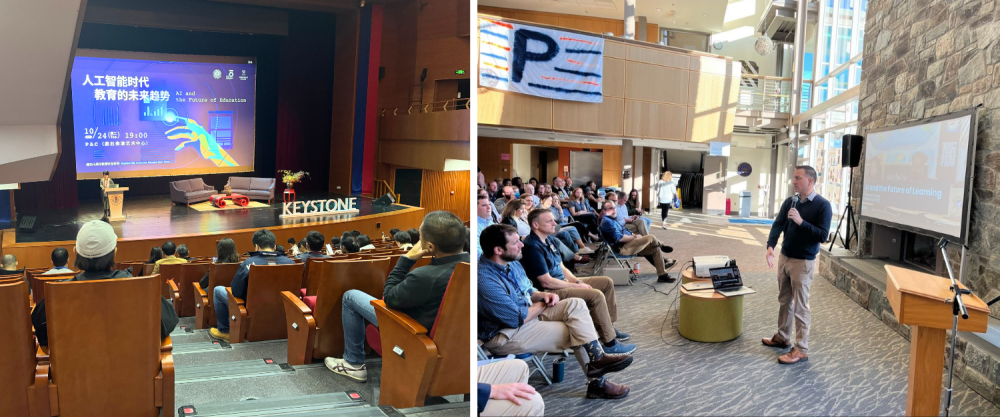Seven Predictions for Education in 2024
As we embrace another year in a very dynamic educational landscape, we find ourselves at the cusp of transformative change. The trends for this upcoming year reflect a blend of important topics that include technology, mental wellness, experiential learning, and innovative evaluation methods.
I’m also taking a look at some of my past predictions and, as expected, they've been a little hit or miss, though I’m also realizing that there’s a bit of a lag in realizing some of these. In 2021, I predicted that the bar for online learning would be raised, and I was right. It’s not that students don’t want online, it’s that they want great online learning experiences. That is definitely something we’re seeing more of at GOA, where half of our students have taken more than one GOA course. The fact that students are re-enrolling at a rate we’ve never seen before is a good indicator that students are actively looking for great learning opportunities no matter where they take place.
I also predicted that “Schools will incorporate Covid innovations into strategic plans,” which is what we’re seeing now. It seems like every school I speak with is undergoing a strategic planning process, and it’s great to hear that they’re asking the question, “what did we do during the pandemic that we can learn from and that we may want to keep?” Schools were forced to do a lot of not great things, but they also innovated like crazy and learned a lot. What were the “Covid keepers” that were improvements of practice, policy, or structure?
Last year I predicted that AI would take off, which now feels super obvious. I’ll have to circle back for some of my others, including year-round schooling, the creation of new roles in schools that are taken from outside the education industry, colleges moving into the high school space, and an overhauling of teacher and school leader preparation and graduate programs.
I’m acutely aware that a lot of my predictions for this year are also hopes for ways that educators can shift mindsets, frameworks, and practices to make learning more engaging for students, work more manageable for teachers, and schools even more joyful places to be. It’s not that we’re lacking these things, but as another year passes we’re given the opportunity to pause, reflect, and think about where we’re headed.
The Expanding Role of AI in Transforming Education
Artificial Intelligence (AI) continues to revolutionize the education sector. AI’s capacity to personalize learning experiences, automate administrative tasks, and provide insights into student performance is unparalleled. It’s not about integrating technology into classrooms; it’s about enhancing pedagogical strategies to cater to diverse learning needs.
The advent of AI in education has opened up new avenues for students to express themselves. For instance, a student with dyslexia, who may struggle with written expression, can now leverage AI-powered drawing tools to articulate their ideas and thoughts through detailed drawings or diagrams. These tools can also help to interpret a student's intentions and assist in creating visuals that effectively convey their ideas, enabling a form of expression that aligns more closely with their cognitive strengths.
This year we’ll also see teachers using AI to significantly ease their workloads. From crafting innovative lesson plans to revamping entire units and courses, teachers will use AI to do more in less time. Teachers will also use AI to analyze student work and provide draft comments, ensuring that feedback is both personalized and efficient, allowing teachers to devote more time to direct student engagement and other critical aspects of their role. AI will be the focus of professional development days at many (if not most) schools.

Fluid, Adaptive, and Responsive Schedules
A key to fostering wellness lies in a fundamental reevaluation of where, when, and how learning transpires within the school setting. Traditionally, rigid student and faculty schedules have been a significant barrier to innovative educational practices. These schedules often dictate pedagogical approaches, with teaching methods and learning experiences being molded to fit predefined time slots, rather than being driven by course objectives and student needs.
Imagine, however, a scenario where student schedules are fluid, adaptive, and responsive to the actual requirements of a student’s learning journey. In this vision, classes convene based on the intrinsic needs of the curriculum and the learners, rather than being tethered to a conventional timetable. This flexibility opens up new possibilities for learning models that are not constrained by the traditional classroom setup. It allows for the creation of dynamic co-working spaces, where students can engage in collaborative group work in an environment that is not bound by the traditional classroom structure. In this model schools will find that they can think differently about how facilities are utilized, opening up the possibility of bringing in more students or using spaces differently.
Growth in Experiential Education
This year we’re going to see a growing emphasis on experiential education, particularly in reconnecting with nature through school programs. “Rewilding” ourselves means stepping out of traditional classroom settings and engaging with our environment. This hands-on approach not only nurtures a love for nature but also underlines the urgency to protect and repair our planet. Incorporating this into K-12 education is crucial for fostering environmentally conscious citizens.
But experiential education goes beyond just being out in nature. It is an educational philosophy that, according to the Association for Experiential Education, “purposefully engage[s]... learners in direct experience and focused reflection in order to increase knowledge, develop skills, clarify values, and develop people's capacity to contribute to their communities.” Getting out of the classroom and engaging directly with our communities, environment, and the people around us are critical aspects of civic engagement, which must be a focus of our schools today.
Through capstones or x-terms students can begin to find ways to connect their studies and their interests beyond the classroom and campuses. Looking at local challenges through the lens of what their learning can be a great way to connect with their communities with an eye toward change. (Our Global Capstone program does this in some really cool ways, too!)
Civic Discourse
As we enter another election year in the U.S. and listen to politicians lambast one another at every turn as we find ourselves inundated by headlines about conflict and strife while watching insularity weave its way through so many different parts of our society, it is paramount that schools deliberately teach civic discourse. We must learn to listen, absorb, reflect, and discuss topics that we don’t all agree on. We must listen to different perspectives and learn from them.
I’m proud of this course that we’re offering next year called Discourse Across Difference that “aims to foster civil discourse, strengthen critical thinking abilities, and build understanding across diverse perspectives.” If the larger trend of discord, division, and disagreement persists, then courses like this will need to be a counter-trend in schools. While skills like these are often woven into other courses, the need to name these skills, extract them, and intentionally create learning opportunities that foster them will be needed now more than ever.
Using AI to Rethink Admissions
The landscape of admission processes is poised for a profound transformation. Moving beyond traditional metrics, we’re going to see a groundbreaking approach: evaluating prospective students through a conversation with an Artificial Intelligence (AI) system. This will allow schools to assess a candidate's curiosity, critical thinking skills, and engagement in a dynamic and interactive manner. By engaging in a dialogue with AI, students have the opportunity to demonstrate their intellectual depth and diverse capabilities, offering a more holistic view of who they are as a learner.
This shift represents a significant move towards recognizing a spectrum of intelligences and abilities that extend beyond mere academic scores. It values the unique perspectives and thought processes of each student, emphasizing attributes like creativity, problem-solving, curiosity, and adaptability. Such an approach not only levels the playing field for students from varied backgrounds but also aligns with the evolving needs of contemporary education and society. By rethinking admission criteria in this way, educational institutions can foster a more inclusive and representative student body, while also ensuring that they are nurturing individuals equipped with the skills and mindsets essential for the challenges of the 21st century.

Shared Teaching Loads
One of the greatest teaching experiences I ever had was team-teaching a 6th grade math class with a colleague. We combined our two classes and split up crafting and teaching lessons, supporting students, and offering feedback on student work. It allowed us to vary the pacing of material if we needed to - one of us could always work with a group of students to speed things up or slow them down according to their needs, while the other kept pace with where the majority of the class was that day. It was beautiful.
The concept of shared teaching loads will be something that gains momentum in schools. This collaborative approach to teaching loads allows educators to pool their expertise and resources, leading to a more enriched learning experience for students. It also addresses teacher burnout, promoting a more sustainable work-life balance for educators by providing flexibility, collaboration, and support. Ensuring the well-being of our teachers is going to be an increasingly important aspect of school leadership who are going to need to find ways to creatively support their faculty. Creating opportunities for increased collegiality and job-embedded collaboration will be part of that task.
Cultivating Leadership through Personal Passions
In the realm of education and leadership, let’s see a trend for leaders and educators to actively pursue their own personal passions. This isn’t merely about personal fulfillment; it serves as a powerful example for students.
Such a model is invaluable in demonstrating to students that success is not confined to the realms of work and academics alone. It underscores the importance of cultivating diverse interests, which contribute to overall well-being and personal growth. Leaders who are passionate about something other than work show that pursuing personal interests can be a source of inspiration, creativity, and even innovative thinking. This will encourage students to view their own interests as more than just leisure activities, but as integral parts of their identity and development.
Ultimately, this philosophy fosters an educational environment where the pursuit of knowledge is balanced with the pursuit of personal passions, creating well-rounded individuals equipped with a broader perspective on life and purpose.
As we look forward to 2024, it's evident that the educational landscape is evolving rapidly, driven by innovation and a deepened understanding of student and teacher needs. These trends are not just fleeting changes; they're signs of a seismic shift in how we approach the work of school. Our collective challenge is to harness these emerging trends in a way that fundamentally enriches the educational experience for all students.
As always, our focus should remain on nurturing a generation of learners who are not only intellectually capable but also emotionally intelligent, culturally aware, and equipped to tackle the complexities of a rapidly changing world. By embracing these trends and continuously reflecting on our practices, we can create learning spaces that are dynamic, inclusive, and truly transformative.
Let's step into 2024 with optimism and a commitment to making education a powerful tool for personal and societal growth. Here's to a year of learning, innovation, and meaningful change in the world of education.
For more, see:
- Back to School 2024: Curiosity vs. Certainty
- The PLaybook: How Do You Show Up? Revisiting Your Educator Presence
- Building a Culture of Feedback in Schools: Strategies, Tools, and Best Practices
GOA serves students, teachers, and leaders and is comprised of member schools from around the world, including independent, international, charter, and public schools. Learn more about Becoming a Member. Our professional learning opportunities are open to any educator or school team. Follow us on LinkedIn. To stay up to date on GOA learning opportunities, sign up for our newsletter.
